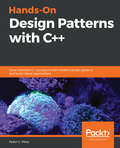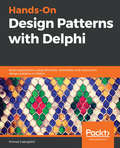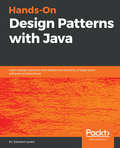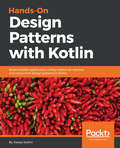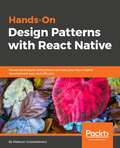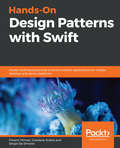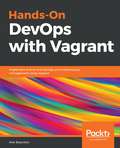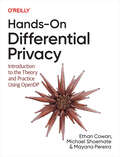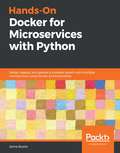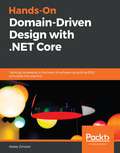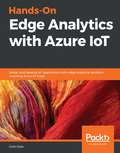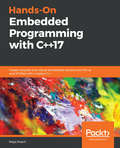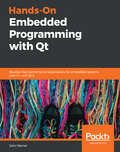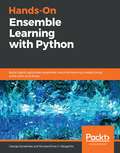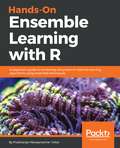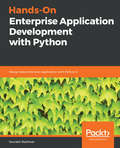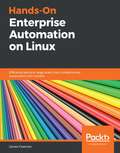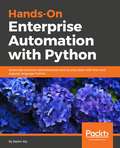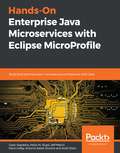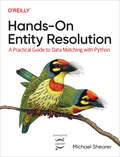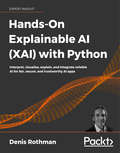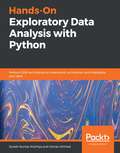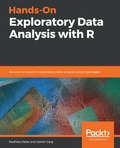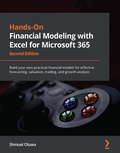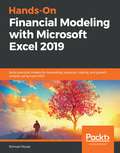- Table View
- List View
Hands-On Design Patterns with C++: Solve common C++ problems with modern design patterns and build robust applications
by Fedor G PikusC++ developers who are comfortable in programming in C++ and now want to learn how to implement design patterns to create robust, reusable and easily maintainable apps.
Hands-On Design Patterns with Delphi: Build applications using idiomatic, extensible, and concurrent design patterns in Delphi
by Primoz GabrijelcicThis book is aimed at beginner to intermediate level Delphi developers who want to build scalable and robust applications. Basic knowledge of Delphi is required and all the advanced Delphi concepts are explained in the book.
Hands-On Design Patterns with Java: Learn design patterns that enable the building of large-scale software architectures
by Dr. Edward LavieriUnderstand Gang of Four, architectural, functional, and reactive design patterns and how to implement them on modern Java platforms, such as Java 12 and beyondKey FeaturesLearn OOP, functional, and reactive patterns for creating readable and maintainable codeExplore architectural patterns and practices for building scalable and reliable applicationsTackle all kinds of performance-related issues and streamline development using design patternsBook DescriptionJava design patterns are reusable and proven solutions to software design problems. This book covers over 60 battle-tested design patterns used by developers to create functional, reusable, and flexible software. Hands-On Design Patterns with Java starts with an introduction to the Unified Modeling Language (UML), and delves into class and object diagrams with the help of detailed examples. You'll study concepts and approaches to object-oriented programming (OOP) and OOP design patterns to build robust applications. As you advance, you'll explore the categories of GOF design patterns, such as behavioral, creational, and structural, that help you improve code readability and enable large-scale reuse of software. You’ll also discover how to work effectively with microservices and serverless architectures by using cloud design patterns, each of which is thoroughly explained and accompanied by real-world programming solutions. By the end of the book, you’ll be able to speed up your software development process using the right design patterns, and you’ll be comfortable working on scalable and maintainable projects of any size.What you will learnUnderstand the significance of design patterns for software engineeringVisualize software design with UML diagramsStrengthen your understanding of OOP to create reusable software systemsDiscover GOF design patterns to develop scalable applicationsExamine programming challenges and the design patterns that solve themExplore architectural patterns for microservices and cloud developmentWho this book is forIf you are a developer who wants to learn how to write clear, concise, and effective code for building production-ready applications, this book is for you. Familiarity with the fundamentals of Java is assumed.
Hands-On Design Patterns with Kotlin: Build scalable applications using traditional, reactive, and concurrent design patterns in Kotlin
by Alexey SoshinMake the most of Kotlin by leveraging design patterns and best practices to build scalable and high performing appsKey Features Understand traditional GOF design patterns to apply generic solutions Shift from OOP to FP; covering reactive and concurrent patterns in a step-by-step manner Choose the best microservices architecture and MVC for your development environmentBook DescriptionDesign patterns enable you as a developer to speed up the development process by providing you with proven development paradigms. Reusing design patterns helps prevent complex issues that can cause major problems, improves your code base, promotes code reuse, and makes an architecture more robust.The mission of this book is to ease the adoption of design patterns in Kotlin and provide good practices for programmers. The book begins by showing you the practical aspects of smarter coding in Kotlin, explaining the basic Kotlin syntax and the impact of design patterns. From there, the book provides an in-depth explanation of the classical design patterns of creational, structural, and behavioral families, before heading into functional programming. It then takes you through reactive and concurrent patterns, teaching you about using streams, threads, and coroutines to write better code along the way By the end of the book, you will be able to efficiently address common problems faced while developing applications and be comfortable working on scalable and maintainable projects of any size.What you will learn Get to grips with Kotlin principles, including its strengths and weaknesses Understand classical design patterns in Kotlin Explore functional programming using built-in features of Kotlin Solve real-world problems using reactive and concurrent design patterns Use threads and coroutines to simplify concurrent code flow Understand antipatterns to write clean Kotlin code, avoiding common pitfalls Learn about the design considerations necessary while choosing between architecturesWho this book is forThis book is for developers who would like to master design patterns with Kotlin to build efficient and scalable applications. Basic Java or Kotlin programming knowledge is assumed
Hands-On Design Patterns with React Native: Proven techniques and patterns for efficient native mobile development with JavaScript
by Mateusz GrzesiukiewiczLearn how to write cross platform React Native code by using effective design patterns in the JavaScript world. Get to know industry standard patterns as well as situational patterns. Decouple your application with these set of “Idea patterns”.Key FeaturesMobile development in React Native should be done in a reusable way. Learn how to build scalable applications using JavaScript patterns that are battle tested.Try effective techniques on your own using over 80 standalone examples.Book DescriptionReact Native helps developers reuse code across different mobile platforms like iOS and Android.This book will show you effective design patterns in the React Native world and will make you ready for professional development in big teams.The book will focus only on the patterns that are relevant to JavaScript, ECMAScript, React and React Native. However, you can successfully transfer a lot of the skills and techniques to other languages. I call them “Idea patterns”.This book will start with the most standard development patterns in React like component building patterns, styling patterns in React Native and then extend these patterns to your mobile application using real world practical examples. Each chapter comes with full, separate source code of applications that you can build and run on your phone.The book is also diving into architectural patterns. Especially how to adapt MVC to React environment. You will learn Flux architecture and how Redux is implementing it. Each approach will be presented with its pros and cons. You will learn how to work with external data sources using libraries like Redux thunk and Redux Saga.The end goal is the ability to recognize the best solution for a given problem for your next mobile application.What you will learnExplore the design Patterns in React NativeLearn the best practices for React Native developmentExplore common React patterns that are highly used within React Native developmentLearn to decouple components and use dependency injection in your applicationsExplore the best ways of fetching data from the backend systemsLearn the styling patterns and how to implement custom mobile designsExplore the best ways to organize your application code in big codebasesWho this book is forThe ideal target audience for this book are people eager to learn React Native design patterns who already know the basics of JavaScript. We can assume that the target audience already knows how to write Hello World in JavaScript and know what are the functions, recursive functions, JavaScript types and loops.
Hands-On Design Patterns with Swift: Master Swift Best Practices To Build Modular Applications For Mobile, Desktop, And Server Platforms
by Florent VilmartThis book is for intermediate developers who want to apply design patterns with Swift to structure and scale their applications. You are expected to have basic knowledge of iOS and Swift.
Hands-On DevOps with Vagrant: Implement end-to-end DevOps and infrastructure management using Vagrant
by Alex BrauntonUse Vagrant to easily build complete development environmentsKey FeaturesImplement DevOps with Vagrant effectivelyIntegrate Vagrant with different tools such as Puppet, Chef, and DockerManage infrastructure with a practical approachBook DescriptionHands-On DevOps with Vagrant teaches you how to use Vagrant as a powerful DevOps tool and gives an overview of how it fits into the DevOps landscape. You will learn how to install VirtualBox and Vagrant in Windows, macOS, and Linux. You will then move on to understanding Vagrant commands, discovering its boxes and Vagrant Cloud.After getting to grips with the basics, the next set of chapters helps you to understand how to configure Vagrant, along with networking. You will explore multimachine, followed by studying how to create multiple environments and the communication between them. In addition to this, you will cover concepts such as Vagrant plugins and file syncing.The last set of chapters provides insights into provisioning shell scripts, also guiding you in how to use Vagrant with configuration management tools such as Chef, Ansible, Docker, Puppet, and Salt.By the end of this book, you will have grasped Vagrant’s features and how to use them for your benefit with the help of tips and tricks.What you will learnExplore what development features Vagrant offersInstall Vagrant and VirtualBox on Windows, macOS and LinuxHarness the power of Vagrant to create powerful development environmentsUtilize DevOps tools such as Docker, Chef, and PuppetUnderstand everything about Vagrant, including networking, plugins, and provisioningUse the Vagrant Cloud to install and manage Vagrant boxesWho this book is forHands-On DevOps with Vagrant is for you if you are a system administrator, DevOps engineer, DevOps architect, or any stakeholder working with DevOps and wanting to explore Vagrant. Experience in system administration is needed to enjoy this book.
Hands-On Differential Privacy
by Ethan Cowan Michael Shoemate Mayana PereiraMany organizations today analyze and share large, sensitive datasets about individuals. Whether these datasets cover healthcare details, financial records, or exam scores, it's become more difficult for organizations to protect an individual's information through deidentification, anonymization, and other traditional statistical disclosure limitation techniques. This practical book explains how differential privacy (DP) can help.Authors Ethan Cowan, Michael Shoemate, and Mayana Pereira explain how these techniques enable data scientists, researchers, and programmers to run statistical analyses that hide the contribution of any single individual. You'll dive into basic DP concepts and understand how to use open source tools to create differentially private statistics, explore how to assess the utility/privacy trade-offs, and learn how to integrate differential privacy into workflows.With this book, you'll learn:How DP guarantees privacy when other data anonymization methods don'tWhat preserving individual privacy in a dataset entailsHow to apply DP in several real-world scenarios and datasetsPotential privacy attack methods, including what it means to perform a reidentification attackHow to use the OpenDP library in privacy-preserving data releasesHow to interpret guarantees provided by specific DP data releases
Hands-On Docker for Microservices with Python: Design, deploy, and operate a complex system with multiple microservices using Docker and Kubernetes
by Jaime BueltaA step-by-step guide to building microservices using Python and Docker, along with managing and orchestrating them with Kubernetes Key Features Learn to use Docker containers to create, operate, and deploy your microservices Create workflows to manage independent deployments on coordinating services using CI and GitOps through GitHub, Travis CI, and Flux Develop a REST microservice in Python using the Flask framework and Postgres database Book Description Microservices architecture helps create complex systems with multiple, interconnected services that can be maintained by independent teams working in parallel. This book guides you on how to develop these complex systems with the help of containers. You'll start by learning to design an efficient strategy for migrating a legacy monolithic system to microservices. You'll build a RESTful microservice with Python and learn how to encapsulate the code for the services into a container using Docker. While developing the services, you'll understand how to use tools such as GitHub and Travis CI to ensure continuous delivery (CD) and continuous integration (CI). As the systems become complex and grow in size, you'll be introduced to Kubernetes and explore how to orchestrate a system of containers while managing multiple services. Next, you'll configure Kubernetes clusters for production-ready environments and secure them for reliable deployments. In the concluding chapters, you'll learn how to detect and debug critical problems with the help of logs and metrics. Finally, you'll discover a variety of strategies for working with multiple teams dealing with different microservices for effective collaboration. By the end of this book, you'll be able to build production-grade microservices as well as orchestrate a complex system of services using containers. What you will learn Discover how to design, test, and operate scalable microservices Coordinate and deploy different services using Kubernetes Use Docker to construct scalable and manageable applications with microservices Understand how to monitor a complete system to ensure early detection of problems Become well versed with migrating from an existing monolithic system to a microservice one Use load balancing to ensure seamless operation between the old monolith and the new service Who this book is for This book is for developers, engineers, or software architects who are trying to move away from traditional approaches for building complex multi-service systems by adopting microservices and containers. Although familiarity with Python programming is assumed, no prior knowledge of Docker is required.
Hands-On Domain-Driven Design with .NET Core: Tackling complexity in the heart of software by putting DDD principles into practice
by Alexey ZimarevSolve complex business problems by understanding users better, finding the right problem to solve, and building lean event-driven systems to give your customers what they really wantKey FeaturesApply DDD principles using modern tools such as EventStorming, Event Sourcing, and CQRSLearn how DDD applies directly to various architectural styles such as REST, reactive systems, and microservicesEmpower teams to work flexibly with improved services and decoupled interactionsBook DescriptionDevelopers across the world are rapidly adopting DDD principles to deliver powerful results when writing software that deals with complex business requirements. This book will guide you in involving business stakeholders when choosing the software you are planning to build for them. By figuring out the temporal nature of behavior-driven domain models, you will be able to build leaner, more agile, and modular systems.You’ll begin by uncovering domain complexity and learn how to capture the behavioral aspects of the domain language. You will then learn about EventStorming and advance to creating a new project in .NET Core 2.1; you’ll also and write some code to transfer your events from sticky notes to C#. The book will show you how to use aggregates to handle commands and produce events. As you progress, you’ll get to grips with Bounded Contexts, Context Map, Event Sourcing, and CQRS. After translating domain models into executable C# code, you will create a frontend for your application using Vue.js. In addition to this, you’ll learn how to refactor your code and cover event versioning and migration essentials.By the end of this DDD book, you will have gained the confidence to implement the DDD approach in your organization and be able to explore new techniques that complement what you’ve learned from the book.What you will learnDiscover and resolve domain complexity together with business stakeholdersAvoid common pitfalls when creating the domain modelStudy the concept of Bounded Context and aggregateDesign and build temporal models based on behavior and not only dataExplore benefits and drawbacks of Event SourcingGet acquainted with CQRS and to-the-point read models with projectionsPractice building one-way flow UI with Vue.jsUnderstand how a task-based UI conforms to DDD principlesWho this book is forThis book is for .NET developers who have an intermediate level understanding of C#, and for those who seek to deliver value, not just write code. Intermediate level of competence in JavaScript will be helpful to follow the UI chapters.
Hands-On Edge Analytics with Azure IoT: Design and develop IoT applications with edge analytical solutions including Azure IoT Edge
by Colin DowDesign, secure, and protect the privacy of edge analytics applications using platforms and tools such as Microsoft's Azure IoT Edge, MicroPython, and Open Source Computer Vision (OpenCV) Key Features Become well-versed with best practices for implementing automated analytical computations Discover real-world examples to extend cloud intelligence Develop your skills by understanding edge analytics and applying it to research activities Book Description Edge analytics has gained attention as the IoT model for connected devices rises in popularity. This guide will give you insights into edge analytics as a data analysis model, and help you understand why it's gaining momentum. You'll begin with the key concepts and components used in an edge analytics app. Moving ahead, you'll delve into communication protocols to understand how sensors send their data to computers or microcontrollers. Next, the book will demonstrate how to design modern edge analytics apps that take advantage of the processing power of modern single-board computers and microcontrollers. Later, you'll explore Microsoft Azure IoT Edge, MicroPython, and the OpenCV visual recognition library. As you progress, you'll cover techniques for processing AI functionalities from the server side to the sensory side of IoT. You'll even get hands-on with designing a smart doorbell system using the technologies you've learned. To remove vulnerabilities in the overall edge analytics architecture, you'll discover ways to overcome security and privacy challenges. Finally, you'll use tools to audit and perform real-time monitoring of incoming data and generate alerts for the infrastructure. By the end of this book, you'll have learned how to use edge analytics programming techniques and be able to implement automated analytical computations. What you will learn Discover the key concepts and architectures used with edge analytics Understand how to use long-distance communication protocols for edge analytics Deploy Microsoft Azure IoT Edge to a Raspberry Pi Create Node-RED dashboards with MQTT and Text to Speech (TTS) Use MicroPython for developing edge analytics apps Explore various machine learning techniques and discover how machine learning is related to edge analytics Use camera and vision recognition algorithms on the sensory side to design an edge analytics app Monitor and audit edge analytics apps Who this book is for If you are a data analyst, data architect, or data scientist who is interested in learning and practicing advanced automated analytical computations, then this book is for you. You will also find this book useful if you're looking to learn edge analytics from scratch. Basic knowledge of data analytics concepts is assumed to get the most out of this book.
Hands-On Embedded Programming with C++17
by Maya PoschIf you want to start developing effective embedded programs in C++, then this book is for you. Good knowledge of C++ language constructs is required to understand the topics covered in the book. No knowledge of embedded systems is assumed.
Hands-On Embedded Programming with Qt: Develop high performance applications for embedded systems with C++ and Qt 5
by John WernerA comprehensive guide that will get you up and running with embedded software development using Qt5 Key Features Learn to create fluid, cross-platform applications for embedded devices Achieve optimum performance in your applications with QT Lite project Explore the implementation of Qt with IoT using QtMqtt, QtKNX, and QtWebSockets Book Description Qt is an open-source toolkit suitable for cross-platform and embedded application development. This book uses inductive teaching to help you learn how to create applications for embedded and Internet of Things (IoT) devices with Qt 5. You'll start by learning to develop your very first application with Qt. Next, you'll build on the first application by understanding new concepts through hands-on projects and written text. Each project will introduce new features that will help you transform your basic first project into a connected IoT application running on embedded hardware. In addition to practical experience in developing an embedded Qt project, you will also gain valuable insights into best practices for Qt development, along with exploring advanced techniques for testing, debugging, and monitoring the performance of Qt applications. Through the course of the book, the examples and projects are demonstrated in a way so that they can be run both locally and on an embedded platform. By the end of this book, you will have the skills you need to use Qt 5 to confidently develop modern embedded applications. What you will learn Understand how to develop Qt applications using Qt Creator under Linux Explore various Qt GUI technologies to build resourceful and interactive applications Understand Qt's threading model to maintain a responsive UI Get to grips with remote target load and debug under Qt Creator Become adept at writing IoT code using Qt Learn a variety of software best practices to ensure that your code is efficient Who this book is for This book is for software and hardware professionals with experience in different domains who are seeking new career opportunities in embedded systems and IoT. Working knowledge of the C++ Linux command line will be useful to get the most out of this book.
Hands-On Ensemble Learning with Python: Build highly optimized ensemble machine learning models using scikit-learn and Keras
by George Kyriakides Konstantinos G. MargaritisCombine popular machine learning techniques to create ensemble models using Python Key Features Implement ensemble models using algorithms such as random forests and AdaBoost Apply boosting, bagging, and stacking ensemble methods to improve the prediction accuracy of your model Explore real-world data sets and practical examples coded in scikit-learn and Keras Book Description Ensembling is a technique of combining two or more similar or dissimilar machine learning algorithms to create a model that delivers superior predictive power. This book will demonstrate how you can use a variety of weak algorithms to make a strong predictive model. With its hands-on approach, you'll not only get up to speed on the basic theory but also the application of various ensemble learning techniques. Using examples and real-world datasets, you'll be able to produce better machine learning models to solve supervised learning problems such as classification and regression. Furthermore, you'll go on to leverage ensemble learning techniques such as clustering to produce unsupervised machine learning models. As you progress, the chapters will cover different machine learning algorithms that are widely used in the practical world to make predictions and classifications. You'll even get to grips with the use of Python libraries such as scikit-learn and Keras for implementing different ensemble models. By the end of this book, you will be well-versed in ensemble learning, and have the skills you need to understand which ensemble method is required for which problem, and successfully implement them in real-world scenarios. What you will learn Implement ensemble methods to generate models with high accuracy Overcome challenges such as bias and variance Explore machine learning algorithms to evaluate model performance Understand how to construct, evaluate, and apply ensemble models Analyze tweets in real time using Twitter's streaming API Use Keras to build an ensemble of neural networks for the MovieLens dataset Who this book is for This book is for data analysts, data scientists, machine learning engineers and other professionals who are looking to generate advanced models using ensemble techniques. An understanding of Python code and basic knowledge of statistics is required to make the most out of this book.
Hands-On Ensemble Learning with R: A beginner's guide to combining the power of machine learning algorithms using ensemble techniques
by Prabhanjan Narayanachar TattarExplore powerful R packages to create predictive models using ensemble methodsKey FeaturesImplement machine learning algorithms to build ensemble-efficient modelsExplore powerful R packages to create predictive models using ensemble methodsLearn to build ensemble models on large datasets using a practical approachBook DescriptionEnsemble techniques are used for combining two or more similar or dissimilar machine learning algorithms to create a stronger model. Such a model delivers superior prediction power and can give your datasets a boost in accuracy.Hands-On Ensemble Learning with R begins with the important statistical resampling methods. You will then walk through the central trilogy of ensemble techniques – bagging, random forest, and boosting – then you'll learn how they can be used to provide greater accuracy on large datasets using popular R packages. You will learn how to combine model predictions using different machine learning algorithms to build ensemble models. In addition to this, you will explore how to improve the performance of your ensemble models.By the end of this book, you will have learned how machine learning algorithms can be combined to reduce common problems and build simple efficient ensemble models with the help of real-world examples.What you will learnCarry out an essential review of re-sampling methods, bootstrap, and jackknifeExplore the key ensemble methods: bagging, random forests, and boostingUse multiple algorithms to make strong predictive modelsEnjoy a comprehensive treatment of boosting methodsSupplement methods with statistical tests, such as ROCWalk through data structures in classification, regression, survival, and time series dataUse the supplied R code to implement ensemble methodsLearn stacking method to combine heterogeneous machine learning modelsWho this book is forThis book is for you if you are a data scientist or machine learning developer who wants to implement machine learning techniques by building ensemble models with the power of R. You will learn how to combine different machine learning algorithms to perform efficient data processing. Basic knowledge of machine learning techniques and programming knowledge of R would be an added advantage.
Hands-On Enterprise Application Development with Python: Design data-intensive Application with Python 3
by Saurabh BadhwarArchitect scalable, reliable, and maintainable applications for enterprises with Python Key Features Explore various Python design patterns used for enterprise software development Apply best practices for testing and performance optimization to build stable applications Learn about different attacking strategies used on enterprise applications and how to avoid them Book Description Dynamically typed languages like Python are continuously improving. With the addition of exciting new features and a wide selection of modern libraries and frameworks, Python has emerged as an ideal language for developing enterprise applications. Hands-On Enterprise Application Development with Python will show you how to build effective applications that are stable, secure, and easily scalable. The book is a detailed guide to building an end-to-end enterprise-grade application in Python. You will learn how to effectively implement Python features and design patterns that will positively impact your application lifecycle. The book also covers advanced concurrency techniques that will help you build a RESTful application with an optimized frontend. Given that security and stability are the foundation for an enterprise application, you'll be trained on effective testing, performance analysis, and security practices, and understand how to embed them in your codebase during the initial phase. You'll also be guided in how to move on from a monolithic architecture to one that is service oriented, leveraging microservices and serverless deployment techniques. By the end of the book, you will have become proficient at building efficient enterprise applications in Python. What you will learn Understand the purpose of design patterns and their impact on application lifecycle Build applications that can handle large amounts of data-intensive operations Uncover advanced concurrency techniques and discover how to handle a large number of requests in production Optimize frontends to improve the client-side experience of your application Effective testing and performance profiling techniques to detect issues in applications early in the development cycle Build applications with a focus on security Implement large applications as microservices to improve scalability Who this book is for If you're a developer who wants to build enterprise-grade applications, this book is for you. Basic to intermediate-level of programming experience with Python and database systems is required to understand the concepts covered in this book.
Hands-On Enterprise Automation on Linux: Efficiently perform large-scale Linux infrastructure automation with Ansible
by James FreemanAchieve enterprise automation in your Linux environment with this comprehensive guide Key Features Automate your Linux infrastructure with the help of practical use cases and real-world scenarios Learn to plan, build, manage, and customize OS releases in your environment Enhance the scalability and efficiency of your infrastructure with advanced Linux system administration concepts Book Description Automation is paramount if you want to run Linux in your enterprise effectively. It helps you minimize costs by reducing manual operations, ensuring compliance across data centers, and accelerating deployments for your cloud infrastructures. Complete with detailed explanations, practical examples, and self-assessment questions, this book will teach you how to manage your Linux estate and leverage Ansible to achieve effective levels of automation. You'll learn important concepts on standard operating environments that lend themselves to automation, and then build on this knowledge by applying Ansible to achieve standardization throughout your Linux environments. By the end of this Linux automation book, you'll be able to build, deploy, and manage an entire estate of Linux servers with higher reliability and lower overheads than ever before. What you will learn Perform large-scale automation of Linux environments in an enterprise Overcome the common challenges and pitfalls of extensive automation Define the business processes needed to support a large-scale Linux environment Get well-versed with the most effective and reliable patch management strategies Automate a range of tasks from simple user account changes to complex security policy enforcement Learn best practices and procedures to make your Linux environment automatable Who this book is for This book is for anyone who has a Linux environment to design, implement, and maintain. Open source professionals including infrastructure architects and system administrators will find this book useful. You're expected to have experience in implementing and maintaining Linux servers along with knowledge of building, patching, and maintaining server infrastructure. Although not necessary, knowledge of Ansible or other automation technologies will be beneficial.
Hands-On Enterprise Automation with Python: Automate common administrative and security tasks with Python
by Bassem AlyInvent your own Python scripts to automate your infrastructureKey FeaturesMake the most of Python libraries and modules to automate your infrastructureLeverage Python programming to automate server configurations and administration tasksEfficiently develop your Python skill setBook DescriptionHands-On Enterprise Automation with Python starts by covering the set up of a Python environment to perform automation tasks, as well as the modules, libraries, and tools you will be using. We’ll explore examples of network automation tasks using simple Python programs and Ansible. Next, we will walk you through automating administration tasks with Python Fabric, where you will learn to perform server configuration and administration, along with system administration tasks such as user management, database management, and process management. As you progress through this book, you’ll automate several testing services with Python scripts and perform automation tasks on virtual machines and cloud infrastructure with Python. In the concluding chapters, you will cover Python-based offensive security tools and learn how to automate your security tasks.By the end of this book, you will have mastered the skills of automating several system administration tasks with Python.What you will learnUnderstand common automation modules used in PythonDevelop Python scripts to manage network devicesAutomate common Linux administration tasks with Ansible and FabricManaging Linux processesAdministrate VMware, OpenStack, and AWS instances with PythonSecurity automation and sharing code on GitHubWho this book is forHands-On Enterprise Automation with Python is for system administrators and DevOps engineers who are looking for an alternative to major automation frameworks such as Puppet and Chef. Basic programming knowledge with Python and Linux shell scripting is necessary.
Hands-On Enterprise Java Microservices with Eclipse MicroProfile: Build and optimize your microservice architecture with Java
by Jeff Mesnil Cesar Saavedra Heiko W. Rupp Pavol Loffay Antoine Sabot-DurandAn effective guide to designing, building, and deploying enterprise Java microservices with Eclipse MicroProfile Key Features Create cloud-native microservices with ease using this detailed guide Avoid vendor lock-in when implementing microservices using Eclipse MicroProfile Discover why MicroProfile is a great specification for building microservices in multi-cloud environments Book Description Eclipse MicroProfile has gained momentum in the industry as a multi-vendor, interoperable, community-driven specification. It is a major disruptor that allows organizations with large investments in enterprise Java to move to microservices without spending a lot on retraining their workforce. This book is based on MicroProfile 2.2, however, it will guide you in running your applications in MicroProfile 3.0. You'll start by understanding why microservices are important in the digital economy and how MicroProfile addresses the need for enterprise Java microservices. You'll learn about the subprojects that make up a MicroProfile, its value proposition to organizations and developers, and its processes and governance. As you advance, the book takes you through the capabilities and code examples of MicroProfile's subprojects - Config, Fault Tolerance, Health Check, JWT Propagation, Metrics, and OpenTracing. Finally, you'll be guided in developing a conference application using Eclipse MicroProfile, and explore possible scenarios of what's next in MicroProfile with Jakarta EE. By the end of this book, you'll have gained a clear understanding of Eclipse MicroProfile and its role in enterprise Java microservices. What you will learn Understand why microservices are important in the digital economy Analyze how MicroProfile addresses the need for enterprise Java microservices Test and secure your applications with Eclipse MicroProfile Get to grips with various MicroProfile capabilities such as OpenAPI and Typesafe REST Client Explore reactive programming with MicroProfile Stream and Messaging candidate APIs Discover and implement coding best practices using MicroProfile Who this book is for If you're a Java developer who wants to create enterprise microservices, this book is for you. Familiarity with Java EE and the concept of microservices will help you get the most out of this book.
Hands-On Entity Resolution: A Practical Guide to Data Matching with Python
by Michael ShearerEntity resolution is a key analytic technique that enables you to identify multiple data records that refer to the same real-world entity. With this hands-on guide, product managers, data analysts, and data scientists will learn how to add value to data by cleansing, analyzing, and resolving datasets using open source Python libraries and cloud APIs.Author Michael Shearer shows you how to scale up your data matching processes and improve the accuracy of your reconciliations. You'll be able to remove duplicate entries within a single source and join disparate data sources together when common keys aren't available. Using real-world data examples, this book helps you gain practical understanding to accelerate the delivery of real business value.With entity resolution, you'll build rich and comprehensive data assets that reveal relationships for marketing and risk management purposes, key to harnessing the full potential of ML and AI. This book covers:Challenges in deduplicating and joining datasetsExtracting, cleansing, and preparing datasets for matchingText matching algorithms to identify equivalent entitiesTechniques for deduplicating and joining datasets at scaleMatching datasets containing persons and organizationsEvaluating data matchesOptimizing and tuning data matching algorithmsEntity resolution using cloud APIsMatching using privacy-enhancing technologies
Hands-On Explainable AI (XAI) with Python: Interpret, visualize, explain, and integrate reliable AI for fair, secure, and trustworthy AI apps
by Denis RothmanThis book is not an introduction to Python programming or machine learning concepts. You must have some foundational knowledge and/or experience with machine learning libraries such as scikit-learn to make the most out of this book. Some of the potential readers of this book include: • Professionals who already use Python for as data science, machine learning, research, and analysis • Data analysts and data scientists who want an introduction into explainable AI tools and techniques • AI Project managers who must face the contractual and legal obligations of AI Explainability for the acceptance phase of their applications
Hands-On Exploratory Data Analysis with Python: Perform EDA techniques to understand, summarize, and investigate your data
by Suresh Kumar Mukhiya Usman AhmedDiscover techniques to summarize the characteristics of your data using PyPlot, NumPy, SciPy, and pandas Key Features Understand the fundamental concepts of exploratory data analysis using Python Find missing values in your data and identify the correlation between different variables Practice graphical exploratory analysis techniques using Matplotlib and the Seaborn Python package Book Description Exploratory Data Analysis (EDA) is an approach to data analysis that involves the application of diverse techniques to gain insights into a dataset. This book will help you gain practical knowledge of the main pillars of EDA - data cleaning, data preparation, data exploration, and data visualization. You'll start by performing EDA using open source datasets and perform simple to advanced analyses to turn data into meaningful insights. You'll then learn various descriptive statistical techniques to describe the basic characteristics of data and progress to performing EDA on time-series data. As you advance, you'll learn how to implement EDA techniques for model development and evaluation and build predictive models to visualize results. Using Python for data analysis, you'll work with real-world datasets, understand data, summarize its characteristics, and visualize it for business intelligence. By the end of this EDA book, you'll have developed the skills required to carry out a preliminary investigation on any dataset, yield insights into data, present your results with visual aids, and build a model that correctly predicts future outcomes. What you will learn Import, clean, and explore data to perform preliminary analysis using powerful Python packages Identify and transform erroneous data using different data wrangling techniques Explore the use of multiple regression to describe non-linear relationships Discover hypothesis testing and explore techniques of time-series analysis Understand and interpret results obtained from graphical analysis Build, train, and optimize predictive models to estimate results Perform complex EDA techniques on open source datasets Who this book is for This EDA book is for anyone interested in data analysis, especially students, statisticians, data analysts, and data scientists. The practical concepts presented in this book can be applied in various disciplines to enhance decision-making processes with data analysis and synthesis. Fundamental knowledge of Python programming and statistical concepts is all you need to get started with this book.
Hands-On Exploratory Data Analysis with R: Become an expert in exploratory data analysis using R packages
by Harish Garg Radhika DatarLearn exploratory data analysis concepts using powerful R packages to enhance your R data analysis skillsKey FeaturesSpeed up your data analysis projects using powerful R packages and techniquesCreate multiple hands-on data analysis projects using real-world dataDiscover and practice graphical exploratory analysis techniques across domainsBook DescriptionHands-On Exploratory Data Analysis with R will help you build not just a foundation but also expertise in the elementary ways to analyze data. You will learn how to understand your data and summarize its main characteristics. You'll also uncover the structure of your data, and you'll learn graphical and numerical techniques using the R language.This book covers the entire exploratory data analysis (EDA) process—data collection, generating statistics, distribution, and invalidating the hypothesis. As you progress through the book, you will learn how to set up a data analysis environment with tools such as ggplot2, knitr, and R Markdown, using tools such as DOE Scatter Plot and SML2010 for multifactor, optimization, and regression data problems.By the end of this book, you will be able to successfully carry out a preliminary investigation on any dataset, identify hidden insights, and present your results in a business context.What you will learnLearn powerful R techniques to speed up your data analysis projectsImport, clean, and explore data using powerful R packagesPractice graphical exploratory analysis techniquesCreate informative data analysis reports using ggplot2Identify and clean missing and erroneous dataExplore data analysis techniques to analyze multi-factor datasetsWho this book is forHands-On Exploratory Data Analysis with R is for data enthusiasts who want to build a strong foundation for data analysis. If you are a data analyst, data engineer, software engineer, or product manager, this book will sharpen your skills in the complete workflow of exploratory data analysis.
Hands-On Financial Modeling with Excel for Microsoft 365: Build your own practical financial models for effective forecasting, valuation, trading, and growth analysis, 2nd Edition
by Shmuel OluwaExplore a variety of Excel features, functions, and productivity tips for various aspects of financial modelingKey FeaturesExplore Excel's financial functions and pivot tables with this updated second editionBuild an integrated financial model with Excel for Microsoft 365 from scratchPerform financial analysis with the help of real-world use casesBook DescriptionFinancial modeling is a core skill required by anyone who wants to build a career in finance. Hands-On Financial Modeling with Excel for Microsoft 365 explores financial modeling terminologies with the help of Excel.Starting with the key concepts of Excel, such as formulas and functions, this updated second edition will help you to learn all about referencing frameworks and other advanced components for building financial models. As you proceed, you'll explore the advantages of Power Query, learn how to prepare a 3-statement model, inspect your financial projects, build assumptions, and analyze historical data to develop data-driven models and functional growth drivers. Next, you'll learn how to deal with iterations and provide graphical representations of ratios, before covering best practices for effective model testing. Later, you'll discover how to build a model to extract a statement of comprehensive income and financial position, and understand capital budgeting with the help of end-to-end case studies.By the end of this financial modeling Excel book, you'll have examined data from various use cases and have developed the skills you need to build financial models to extract the information required to make informed business decisions.What you will learnIdentify the growth drivers derived from processing historical data in ExcelUse discounted cash flow (DCF) for efficient investment analysisPrepare detailed asset and debt schedule models in ExcelCalculate profitability ratios using various profit parametersObtain and transform data using Power QueryDive into capital budgeting techniquesApply a Monte Carlo simulation to derive key assumptions for your financial modelBuild a financial model by projecting balance sheets and profit and lossWho this book is forThis book is for data professionals, analysts, traders, business owners, and students who want to develop and implement in-demand financial modeling skills in their finance, analysis, trading, and valuation work. Even if you don't have any experience in data and statistics, this book will help you get started with building financial models. Working knowledge of Excel is a prerequisite.
Hands-On Financial Modeling with Microsoft Excel 2019: Build practical models for forecasting, valuation, trading, and growth analysis using Excel 2019
by Shmuel OluwaExplore the aspects of financial modeling with the help of clear and easy-to-follow instructions and a variety of Excel features, functions, and productivity tips Key Features A non data professionals guide to exploring Excel's financial functions and pivot tables Learn to prepare various models for income and cash flow statements, and balance sheets Learn to perform valuations and identify growth drivers with real-world case studies Book Description Financial modeling is a core skill required by anyone who wants to build a career in finance. Hands-On Financial Modeling with Microsoft Excel 2019 examines various definitions and relates them to the key features of financial modeling with the help of Excel. This book will help you understand financial modeling concepts using Excel, and provides you with an overview of the steps you should follow to build an integrated financial model. You will explore the design principles, functions, and techniques of building models in a practical manner. Starting with the key concepts of Excel, such as formulas and functions, you will learn about referencing frameworks and other advanced components of Excel for building financial models. Later chapters will help you understand your financial projects, build assumptions, and analyze historical data to develop data-driven models and functional growth drivers. The book takes an intuitive approach to model testing, along with best practices and practical use cases. By the end of this book, you will have examined the data from various use cases, and you will have the skills you need to build financial models to extract the information required to make informed business decisions. What you will learn Identify the growth drivers derived from processing historical data in Excel Use discounted cash flow (DCF) for efficient investment analysis Build a financial model by projecting balance sheets, profit, and loss Apply a Monte Carlo simulation to derive key assumptions for your financial model Prepare detailed asset and debt schedule models in Excel Discover the latest and advanced features of Excel 2019 Calculate profitability ratios using various profit parameters Who this book is for This book is for data professionals, analysts, traders, business owners, and students, who want to implement and develop a high in-demand skill of financial modeling in their finance, analysis, trading, and valuation work. This book will also help individuals that have and don't have any experience in data and stats, to get started with building financial models. The book assumes working knowledge with Excel.
